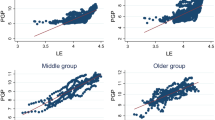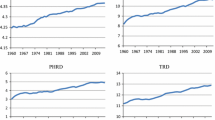Abstract
In the United States, health economists, experts in population studies, and policy makers seek to understand the important factors that augment life expectancy. This paper attempts to identify empirically effects of some major determinants on life expectancy in the United States during the period 1960–2012. Recently developed powerful methods of unit root testing and cointegration analysis, Carrion-i-Silvestre et al. Economet Theor, 25, 1754–1792, (2009), Perron and Yabu J Bus Econ Stat, 27, 369–96, (2009), Kejriwal and Perron J Econ, 146(1), 59–73, (2008), Kejriwal and Perron J Bus Econ Stat, 28(4), 503–522, (2010a), and Maki Econ Model, 29(5), 2011–2015, (2012) that allow for the presence of structural shifts, are employed. The papers’ findings reveal that the level of real per capita income and the level of educational attainment are the factors that affect the level of life expectancy most. Other factors such as the level of real health expenditure per capita and any measure of income inequality, although important, were found to be highly collinear with real per capita income. The policy implications of the results of the paper are discussed.
Similar content being viewed by others
References
Anderson GF, Frogner BK (2008) Health spending in OECD countries: obtaining value per dollar. Health Aff 27:1718–1727
Andrews DWK, Ploberger W (1994) Optimal tests when a nuisance parameter is present only under the alternative. Econometrica 62:1383–1414
Bai J, Perron P (1998) Estimating and testing linear models with multiple structural changes. Econometrica 66:47–68
Bai J, Perron P (2003) Computation and analysis of multiple structural change models. J Appl Econ 18:1–22
Becker GS, Mulligan CB (1997) The endogenous determination of time preference. Q J Econ 112(3):729–758
Bloom DE, Canning D (2007) Commentary: the Preston curve 30 years on: still sparking fire. Int J Epidemiol 36:498
Carrion-i-Silvestre JL, Kim D, Perron P (2009) GLS-based unit root tests with multiple structural breaks under both the null and the alternative hypotheses. Economet Theor 25:1754–1792
Cutler DM, Lleras-Muney A (2007) Education and health: evaluating theories and evidence. In: House JS, Schoeni RF, Kaplan GA, Pollack H (eds) The Health Effects of Social and Economic Policy. Russel Sage Foundation, New York
Cutler DM, Lleras-Muney A (2010) Understanding differences in health behaviors by education. J Health Econ 29:1–28
Cutler DM, Lleras-Muney A (2012) Education and health: international comparisons. NBER Working Paper 17738:1–30
Cutler DM, Meara ER, Richards S (2008) The gap gets bigger: changes in mortality and life expectancy by education, 1981–2000. Health Aff 27:350–360
Deaton A, Cutler DM, Lleras-Muney A (2006) The determinants of mortality. J Econ Perspect 20:97–120
Dimitriou D, Simos T (2013) Testing purchasing power parity for Japan and the US: a structural- break approach. Jpn World Econ 28:53–59
Elliot G, Rothenberg TJ, Stock JH (1996) Efficient tests for an autoregressive: unit root. Econometrica 64:813–836
Foster AD, Rosenzweig MR (2010) Microeconomics of technology adoption. Annual Review of Economics 2:395–424
Gregory AW, Hansen BE (1996) Residual- based tests for Cointegration in model with regime shifts. J Econ 70:99–126
Grossman M (1972) The demand for health–a theoretical and empirical investigation. National Bureau of Economic Research, New York
Hatemi AJ (2008) Tests for Cointegration with two unknown regime shifts with an application to financial market integration. Empir Econ 35:497–505
Johansen S (1992) Estimation and hypothesis testing of cointegration vectors in Gaussian vector autoregressive models. Econometrics 59:1551–1580
Johansen S (1995) Identifying restrictions of linear equations with applications to simultaneous equations and cointegration. J Econ 69(1):111–132
Johansen S (1996) Likelihood based inference in cointegrated vector autoregressive models. Oxford University Press, Oxford
Jones C, Hall R (2007) The value of life and the rise in health spending. The Quarterly Journal of Health Economics 72:39–72
Kapetanios G (2005) Unit-root testing against the alternative hypothesis of up to m structural breaks. J Time Ser Anal 26:123–133
Kejriwal M, Perron P (2008) The limit distribution of the estimates in Cointegrated regression models with multiple structural changes. J Econ 146(1):59–73
Kejriwal M, Perron P (2010a) Testing for multiple structural changes in Cointegrated regression models. J Bus Econ Stat 28(4):503–522
Kejriwal M, Perron P (2010b) A sequential procedure to determine the number of breaks in trend with an integrated or stationary noise component. J Time Ser Anal 31:305–328
Kim D, Perron P (2009) Unit root test allowing for a break in the trend function under both the null and alternative hypothesis. J Econ 148:1–13
Kitagawa EM, Hauser PM (1973) Differential mortality in the United States: a study in socioeconomic epidemiology. University Press, Cambridge
Kiuila O, Mieszkowski P (2007) The effects of income, education and age on health. Health Econ 16:781–798
Liu J, Wu S, Zidek JV (1997) On segmented multivariate regressions. Stat Sin 7:497–525
Lleras-Muney A, Lichtenberg F (2005) The effect of education on medical technology adoption: are the more educated more likely to use new drugs, special issue of the Annales d’Economie et Statistique in memory of Zvi Griliches, no.79/80
MacDonald R (2000) Is the foreign exchange market ‘risky’? Some new survey based results. Journal of Multinational Financial Management 10:1–14
Maki D (2012) Tests for Cointegration allowing for an unknown number of breaks. Econ Model 29(5):2011–2015
Ng S, Perron P (2001) Lag selection and the construction of unit root tests with good size and power. Econometrica 69:1519–1554
Nixon J, Ulmann P (2006) The relationship between health care expenditure and health outcomes. Evidence and Caveates for a causal link. Eur J Health Econ 7:7–18
OECD (2001) The well-being of nations: the role of human and social capital, OECD Publishing, Paris. doi:10.1787/9789264189515-en
OECD (2013a) OECD Health Data 2013. OECD online database.
OECD (2013b) Health at A Glance 2013OECD Indicators, OECD Publishing, Paris. doi:10.1787/health_glance-2013-en
Perron P (1989) The great crash, the oil price crash, and the unit root hypothesis. Econometrica 57:1361–1401
Perron P (1997) Further evidence on breaking trend functions in macroeconomic variables. J Econ 80:355–385
Perron P, Ng S (1996) Useful modifications to some unit root tests with dependent errors and their local asymptotic properties. Rev Econ Stud 63:435–463
Perron P, Vogelsang T (1992) Non-stationarity and level shifts with an application to purchasing power parity. J Bus Econ Stat 10:301–320
Perron P, Yabu T (2009) Testing for shifts in trend with an integrated or stationary noise component. J Bus Econ Stat 27:369–396
Phelan J, Link B (2003) When income affects outcome: socioeconomic status and health, in research in profile series, 6. http://www.investigatorawards.org/downloads/research_in_profiles_iss06_feb2003.pdf. Accessed 13 Dec 2011
Preston SH (1975) The changing relation between mortality and level of economic development. Popul Stud 29:484–490
Pritchett L, Summers H (1996) Wealthier is healthier. J Hum Resour 31(4):841–868
Ricci F, Zachariadis (2008) Longevity and Education Externalities: A Macroeconomic Perspective, Available at www2.toulouse.inra.fr/lerna/travaux/cahiers2009/09.02.278.pdf
Shaw JW, Horrace WC, Vogel R (2005) The determinants of life expectancy: an analysis of OECD health data. South Econ J 71:768–783
United Census Bureau, Current Population Survey Historical Tables (2014) https://www.census.gov/data/tables/time-series/demo/educational-attainment/CPS-historical-timeseries.html
Vogelsang TJ, Perron P (1998) Additional tests for a unit root allowing for a break in the trend function at an unknown time. Int Econ Rev 39:1073–1100
Zivot E, Andrews D (1992) Further evidence of Great Crash, the oil price shock and unit root hypothesis. J Bus Econ Stat 10(3):251–270
Acknowledgements
This paper was written while the second author was on sabbatical during the spring semester of 2015.
Author information
Authors and Affiliations
Corresponding author
Rights and permissions
About this article
Cite this article
Ketenci, N., Murthy, V.N.R. Some determinants of life expectancy in the United States: results from cointegration tests under structural breaks. J Econ Finan 42, 508–525 (2018). https://doi.org/10.1007/s12197-017-9401-2
Published:
Issue Date:
DOI: https://doi.org/10.1007/s12197-017-9401-2




